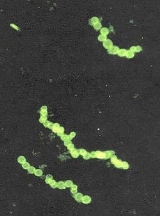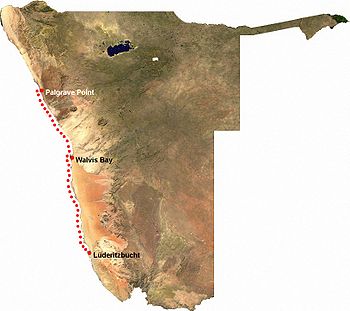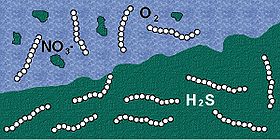
Thiomargarita namibiensis
Encyclopedia
Thiomargarita namibiensis is a gram-negative
coccoid
Proteobacterium
, found in the ocean sediments of the continental shelf
of Namibia
. It is the largest bacterium
ever discovered, in general, 0.1–0.3 mm (100–300 µm) wide, but sometimes up to 0.75 mm (750 µm). Its size is large enough to be seen by the naked eye.
The genus name originates from Greek
θεῖον (theion) = sulfur (see Thio-), and Latin
margarita = pearl. This is a reference to the fact that the bacterium-chains have the appearance of a thin string of pearls, due to microscopic sulfur granules inside the bacteria, reflecting the incident light. The species name namibiensis indicates its origins in coastal Namibia, meaning Sulfur pearl of Namibia.
. There are no other species in the genus Thiomargarita.
The previously largest known bacterium was Epulopiscium fishelsoni
, at 0.5 mm long.


as the terminal electron acceptor in the electron transport chain
. The organism will oxidize hydrogen sulfide
(H2S) into elemental sulfur
(S). This is deposited as granules in its cytoplasm and is highly refractile and opalescent, making the organism look like a pearl.
While the sulfide is available in the surrounding sediment, produced by other bacteria from dead microalgae that sank down to the sea bottom, the nitrate comes from the above seawater. Since the bacterium is sessile
, and the concentration of available nitrate fluctuates considerably over time, it stores nitrate at high concentration (up to 800 millimolar) in a large vacuole
, like an inflated balloon, which is responsible for about 80% of its size. When nitrate concentrations in the environment are low, the bacteria uses the contents of its vacuole for respiration. Thus, the presence of a central vacuole in its cells enables a prolonged survival in sulfidic sediments. The non-motility of Thiomargarita cells is compensated by its large cellular size.
Recent research has also indicated that the bacteria may be facultatively anaerobic
rather than obligately anaerobic, and thus capable of respiring with oxygen if it is plentiful.
Gram-negative
Gram-negative bacteria are bacteria that do not retain crystal violet dye in the Gram staining protocol. In a Gram stain test, a counterstain is added after the crystal violet, coloring all Gram-negative bacteria with a red or pink color...
coccoid
Coccus
Coccus can be used to describe any bacterium that has a spherical shape. It is one of the three distinct types of bacteria shapes, the other two being bacillus and spirillum cells...
Proteobacterium
Proteobacteria
The Proteobacteria are a major group of bacteria. They include a wide variety of pathogens, such as Escherichia, Salmonella, Vibrio, Helicobacter, and many other notable genera....
, found in the ocean sediments of the continental shelf
Continental shelf
The continental shelf is the extended perimeter of each continent and associated coastal plain. Much of the shelf was exposed during glacial periods, but is now submerged under relatively shallow seas and gulfs, and was similarly submerged during other interglacial periods. The continental margin,...
of Namibia
Namibia
Namibia, officially the Republic of Namibia , is a country in southern Africa whose western border is the Atlantic Ocean. It shares land borders with Angola and Zambia to the north, Botswana to the east and South Africa to the south and east. It gained independence from South Africa on 21 March...
. It is the largest bacterium
Bacteria
Bacteria are a large domain of prokaryotic microorganisms. Typically a few micrometres in length, bacteria have a wide range of shapes, ranging from spheres to rods and spirals...
ever discovered, in general, 0.1–0.3 mm (100–300 µm) wide, but sometimes up to 0.75 mm (750 µm). Its size is large enough to be seen by the naked eye.
The genus name originates from Greek
Greek language
Greek is an independent branch of the Indo-European family of languages. Native to the southern Balkans, it has the longest documented history of any Indo-European language, spanning 34 centuries of written records. Its writing system has been the Greek alphabet for the majority of its history;...
θεῖον (theion) = sulfur (see Thio-), and Latin
Latin
Latin is an Italic language originally spoken in Latium and Ancient Rome. It, along with most European languages, is a descendant of the ancient Proto-Indo-European language. Although it is considered a dead language, a number of scholars and members of the Christian clergy speak it fluently, and...
margarita = pearl. This is a reference to the fact that the bacterium-chains have the appearance of a thin string of pearls, due to microscopic sulfur granules inside the bacteria, reflecting the incident light. The species name namibiensis indicates its origins in coastal Namibia, meaning Sulfur pearl of Namibia.
Occurrence
The species was discovered by Heide N. Schulz and others in 1997, in the coastal seafloor sediments of Walvis Bay (Namibia). In 2005, a closely related strain was discovered in the Gulf of MexicoGulf of Mexico
The Gulf of Mexico is a partially landlocked ocean basin largely surrounded by the North American continent and the island of Cuba. It is bounded on the northeast, north and northwest by the Gulf Coast of the United States, on the southwest and south by Mexico, and on the southeast by Cuba. In...
. There are no other species in the genus Thiomargarita.
The previously largest known bacterium was Epulopiscium fishelsoni
Epulopiscium fishelsoni
Epulopiscium fishelsoni is a Gram-positive bacterium that has a symbiotic relationship with the surgeonfish. It is most well known for its large size, ranging from 200-700 μm in length, and about 80 μm in diameter...
, at 0.5 mm long.


Metabolism
The bacterium is chemolithotrophic, and is capable of using nitrateNitrate
The nitrate ion is a polyatomic ion with the molecular formula NO and a molecular mass of 62.0049 g/mol. It is the conjugate base of nitric acid, consisting of one central nitrogen atom surrounded by three identically-bonded oxygen atoms in a trigonal planar arrangement. The nitrate ion carries a...
as the terminal electron acceptor in the electron transport chain
Electron transport chain
An electron transport chain couples electron transfer between an electron donor and an electron acceptor with the transfer of H+ ions across a membrane. The resulting electrochemical proton gradient is used to generate chemical energy in the form of adenosine triphosphate...
. The organism will oxidize hydrogen sulfide
Hydrogen sulfide
Hydrogen sulfide is the chemical compound with the formula . It is a colorless, very poisonous, flammable gas with the characteristic foul odor of expired eggs perceptible at concentrations as low as 0.00047 parts per million...
(H2S) into elemental sulfur
Sulfur
Sulfur or sulphur is the chemical element with atomic number 16. In the periodic table it is represented by the symbol S. It is an abundant, multivalent non-metal. Under normal conditions, sulfur atoms form cyclic octatomic molecules with chemical formula S8. Elemental sulfur is a bright yellow...
(S). This is deposited as granules in its cytoplasm and is highly refractile and opalescent, making the organism look like a pearl.
While the sulfide is available in the surrounding sediment, produced by other bacteria from dead microalgae that sank down to the sea bottom, the nitrate comes from the above seawater. Since the bacterium is sessile
Sessility (zoology)
In zoology, sessility is a characteristic of animals which are not able to move about. They are usually permanently attached to a solid substrate of some kind, such as a part of a plant or dead tree trunk, a rock, or the hull of a ship in the case of barnacles. Corals lay down their own...
, and the concentration of available nitrate fluctuates considerably over time, it stores nitrate at high concentration (up to 800 millimolar) in a large vacuole
Vacuole
A vacuole is a membrane-bound organelle which is present in all plant and fungal cells and some protist, animal and bacterial cells. Vacuoles are essentially enclosed compartments which are filled with water containing inorganic and organic molecules including enzymes in solution, though in certain...
, like an inflated balloon, which is responsible for about 80% of its size. When nitrate concentrations in the environment are low, the bacteria uses the contents of its vacuole for respiration. Thus, the presence of a central vacuole in its cells enables a prolonged survival in sulfidic sediments. The non-motility of Thiomargarita cells is compensated by its large cellular size.
Recent research has also indicated that the bacteria may be facultatively anaerobic
Facultative anaerobic organism
A facultative anaerobic organism is an organism, usually a bacterium, that makes ATP by aerobic respiration if oxygen is present but is also capable of switching to fermentation...
rather than obligately anaerobic, and thus capable of respiring with oxygen if it is plentiful.

